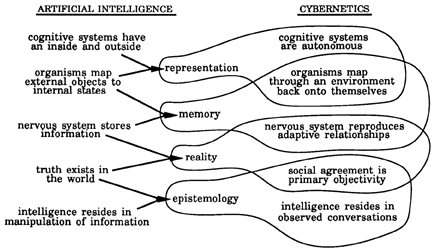Artificial Intelligence and CyberneticsGeorge Washington UniversityCourse ID Management 265 Department of Management Science Spring 1990 Paul Pangaro, Instructor [The following text and figure constituted a course description taught to approximately 25 students. Some colleagues upon hearing of this activity dubbed the course title, "AI versus Cybernetics."] Artificial Intelligence and Cybernetics: Aren't they the same thing? Isn't one just about computers and the other about robots? The answer to these questions is emphatically, No.  The field of Artificial Intelligence (AI) came into being when concepts of universal computation, the brain as computer, and digital computing were combined. Fundamentally concerned with demonstration and application, AI moved inevitably to assume the challenge of reproducing and/or explaining human mentation, problem solving and language. It stands today as a major influence on the fields of biology, cognitive and computation science, and epistemology. The field of Cybernetics came into being when concepts of information, feedback and control were generalized from specific applications to systems in general, including systems of living organisms, systems of self-reference and systems of language. Fundamentally an applied philosophy, cybernetics has taken on problems of subjectivity in science while still addressing how to make intelligent artifacts. It stands today as a major influence on biology, cognitive and computation science, and epistemology. Ironically but logically, AI and Cybernetics have each gone in and out of fashion and influence. Cybernetics started a bit in advance of AI, but AI has dominated for the last 25 years. Now recent difficulties in AI have led to renewed search for solutions that mirror the past approaches of Cybernetics. In this course, the distinct roots and applications of each field will be studied, and the implications of their future influences will be explored. The objectives of the course are to provide:
Related Course:
|
|
© Copyright Paul Pangaro 1994 - 2000. All Rights Reserved. |
|